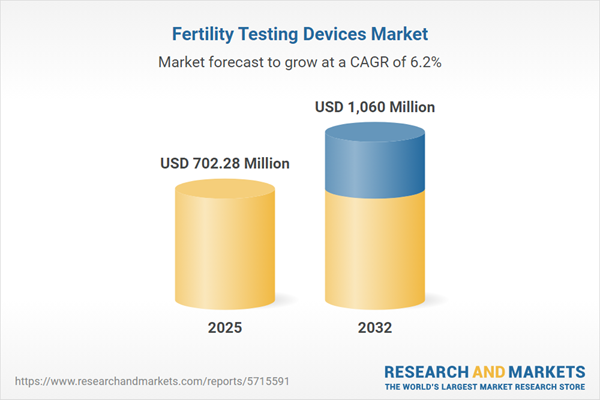Speak directly to the analyst to clarify any post sales queries you may have.
The fertility testing devices market is transforming as digital innovation and enhanced user experiences reshape diagnostics for clinical and home settings. Senior leaders need concise insights to proactively address shifts in technology, patient needs, and healthcare delivery approaches.
Market Snapshot: Fertility Testing Devices Market Dynamics
Global demand for fertility testing devices continues to gain momentum, propelled by sustained growth in digital and wearable diagnostics. This expansion is enabling broader use in clinics, homes, and telemedicine. Advances in device connectivity and user interface design are making fertility testing easier and more accessible, supporting adoption in both developed and emerging markets. Manufacturers are adapting quickly, launching solutions tailored for regional healthcare environments and evolving regulations. As technology accelerates, key players are leveraging innovation to reinforce their strategic positioning and capture new opportunities within the fertility testing devices market.
Scope & Segmentation: Comprehensive Insights for Senior Leaders
Strategic segmentation offers senior executives the clarity required to guide investments and operational strategies. Understanding the full range of solutions and their users enables precise targeting and improved regulatory compliance on a global scale.
- Product Types: Handheld monitors, wearables, and ovulation and pregnancy tests—available in both digital and analog formats—address various applications in clinical, home, and telemedicine contexts, meeting the increasing demand for versatility across user environments.
- End Users: Solutions developed for healthcare professionals and individual users focus on privacy, intuitive operation, and reliable results, supporting high expectations for convenience and precision.
- Sales Channels: Online and retail segments are adapting to changing buying behaviors, promoting flexible distribution and greater reach tailored to regional preferences and the expanding digital health landscape.
- Technologies: App-based connectivity, digital diagnostics, and conventional testing are enhancing results accuracy, enabling real-time monitoring, and offering seamless data management for both patients and clinicians.
- Regional Coverage: The Americas, EMEA, and Asia-Pacific present distinct drivers—including healthcare infrastructure variations, regulatory differences, and digital maturity—requiring region-specific market entry strategies and compliance frameworks.
- Company Profiles: Leading organizations such as Procter & Gamble Company, Church & Dwight Co., F. Hoffmann-La Roche Ltd., Abbott Laboratories, Danaher Corporation, Thermo Fisher Scientific, Siemens Healthineers AG, Becton, Dickinson and Company, Bio-Rad Laboratories, and Quidel Corporation continue to shape the landscape through ongoing innovation and expanded product portfolios.
Key Takeaways for Senior Decision-Makers
- Digital-first diagnostics and streamlined interfaces are elevating reliability, expanding adoption across clinical and at-home settings, and supporting growth in diverse user segments.
- Integration with mobile applications enables tailored patient management and personalized care, making fertility support more accessible and adaptable to individual needs.
- A proactive approach to regulation and reimbursement shifts is essential, as organizations must account for regional differences in health system technology and policy.
- The inclusion of male fertility solutions and next-generation wearables is unlocking new markets, serving previously underrepresented groups and enhancing device uptake.
- Telemedicine integration and omnichannel distribution strategies are increasing market visibility, improving access to advanced diagnostic tools, and responding to evolving care pathways.
- Supply chain agility, including vertical integration and supplier diversification, remains critical to mitigating risks and ensuring consistent device availability during regulatory and logistical changes.
Tariff Impact and Supply Chain Adaptation
Recent tariffs affecting medical device components have prompted manufacturers to review their sourcing models. Efforts to shift toward near-shoring and expand supplier partnerships are reinforcing production continuity and increasing resilience amid changing regulatory requirements within the fertility testing devices market.
Methodology & Data Sources
This market overview draws on authoritative industry publications and specialized databases, complemented by expert interviews and focused panels. These approaches validate the findings and ensure that the insights are both actionable and relevant for executive decision-making.
Why This Report Matters for Stakeholders
- Enhances strategic planning and resource allocation through clear analysis of technology trends, competitor actions, and regulatory developments.
- Strengthens ability to address evolving risks and leverage opportunities, supporting adaptation to the fast-changing digital health environment.
- Empowers proactive adjustment to shifting care models and digital transformation trajectories in the fertility diagnostics sector.
Conclusion
By leveraging these comprehensive insights, senior leaders can drive digital health initiatives, remain responsive to market shifts in fertility diagnostics, and secure a strong competitive position.
Additional Product Information:
- Purchase of this report includes 1 year online access with quarterly updates.
- This report can be updated on request. Please contact our Customer Experience team using the Ask a Question widget on our website.
Table of Contents
3. Executive Summary
4. Market Overview
7. Cumulative Impact of Artificial Intelligence 2025
Companies Mentioned
The companies profiled in this Fertility Testing Devices market report include:- Procter & Gamble Company
- Church & Dwight Co., Inc.
- F. Hoffmann-La Roche Ltd.
- Abbott Laboratories
- Danaher Corporation
- Thermo Fisher Scientific Inc.
- Siemens Healthineers AG
- Becton, Dickinson and Company
- Bio-Rad Laboratories, Inc.
- Quidel Corporation
Table Information
| Report Attribute | Details |
|---|---|
| No. of Pages | 192 |
| Published | October 2025 |
| Forecast Period | 2025 - 2032 |
| Estimated Market Value ( USD | $ 702.28 Million |
| Forecasted Market Value ( USD | $ 1060 Million |
| Compound Annual Growth Rate | 6.1% |
| Regions Covered | Global |
| No. of Companies Mentioned | 11 |









